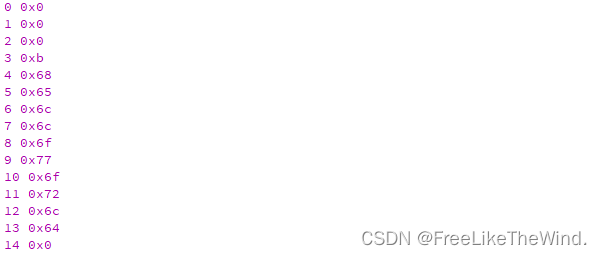【Qt】使用QDataStream向QByteArray内读写数据时,输出QByteArray数据为空解决方案
原因
今天写示例时,用到使用QDataStream类向QByteArray读写数据,但打印出来为空。
下面是简化代码:
QByteArray ba;
QDataStream out(&ba, QIODevice::WriteOnly);
out << "helloworld";
qDebug().noquote() << "ba :" << ba.length() << ba.data();
输出如下:

可以看到,只输出了长度为15, 后面的数据并没有输出。并且长度好像也不对,因为即使加上\0也才11个字节。
这是为什么呢?
翻阅相关文档
查看QDataStream类
QDataStream::QDataStream(QByteArray *a, QIODevice::OpenMode mode)
解释就是:
构造在字节数组a上操作的数据流。模式描述如何使用设备。
另外,如果只想从字节数组中读取数据,也可以使用QDataStream(const QByteArray &)。
由于QByteArray不是QIODevice的子类,因此在内部创建了一个QBuffer来包装字节数组。
由以上可以得出:
因为QByteArray不是一个继承自QIODevice的类,所以QDataStream类在处理它的时候会创建一个QBuffer类.而QBuffer是继承自QIODevice类的。
但以上只是说了这样用的依据,并不能解释为什么长度会是15,而且还没有输出数据。
打印
为了验证,所以将ba进行打印。
for (int i = 0; i < ba.length(); i++)
{
qDebug().noquote() << i << showbase << hex << (int)ba.at(i);
}
输出结果有了:

好像写入的数据有,但前面多了四个字节的样子。
继续查看QDataStream文档,看下以下信息:
To take one example, a char * string is written as a 32-bit integer
equal to the length of the string including the ‘\0’ byte, followed by
all the characters of the string including the ‘\0’ byte. When
reading a char * string, 4 bytes are read to create the 32-bit length
value, then that many characters for the char * string including the
‘\0’ terminator are read. The initial I/O device is usually set in the
constructor, but can be changed with setDevice(). If you’ve reached
the end of the data (or if there is no I/O device set) atEnd() will
return true.
说的意思呢,就是:
在使用QDataStream向一个QByteArray中写入数据时,会首先写入一个32位的整数,这个整数保存了此QByteArray的长度('\0’也算一个字符),当从这个QDataStream中读QByteArray中的一个字符串时会首读取这个字符串中一共有多少个字符,也就是开始的那4个byte,然后再读取字符串的内容。
回过来,看打印信息,第四个字节是0x0b,就是十进制的11,而helloworld字符串长度包含后面的\0就是11个字节。刚刚好。
说明信息是存在的。
结果
现在既然知道问题所在了,如果想打印输出,只需要将前面的4个字节给忽略就可以用QDebug进行输出了。
以下是完善代码:
QByteArray ba;
QDataStream out(&ba, QIODevice::WriteOnly);
out << "helloworld";
qDebug().noquote() << "ba :" << ba.length() << ba.data()+4;

结论
学而不思,不如刷抖音。
本文来自互联网用户投稿,该文观点仅代表作者本人,不代表本站立场。本站仅提供信息存储空间服务,不拥有所有权,不承担相关法律责任。 如若内容造成侵权/违法违规/事实不符,请联系我的编程经验分享网邮箱:chenni525@qq.com进行投诉反馈,一经查实,立即删除!
- Python教程
- 深入理解 MySQL 中的 HAVING 关键字和聚合函数
- Qt之QChar编码(1)
- MyBatis入门基础篇
- 用Python脚本实现FFmpeg批量转换
- 【BBuf的CUDA笔记】十二,LayerNorm/RMSNorm的重计算实现
- AP5193 DC-DC宽电压LED降压恒流IC 调光 电阻调频 LED电源车灯驱动
- uniapp中打包Andiord app,在真机调试时地图以及定位功能可以正常使用,打包成app后失效问题(高德地图)
- 2023/12/22 work
- Python学习(7)|字符串_str()_字符提取_replace()_内存分析_字符串切片_slice操作_逆序
- 用例状态
- java常见面试题:如何使用Java进行Spring Boot框架开发?
- Python 进阶(十八):配置文件(configparser 模块)
- 基于大数据的地域职位需求和薪资分析
- transforms图像增强(一)